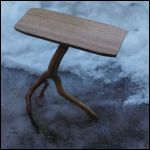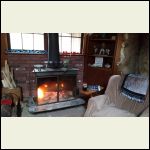|
| Author |
Message |
willywilly2020
Member
|
# Posted: 5 Nov 2020 10:53
Reply
Hi friends!
I milled some really beautiful 2" cedar slabs from some dead standing cedar on my property this summer. I built some stairs, and a bench. And I am using the remaining for my countertops and table. I'm going to treat them (oil, poly, varnish, etc., ) to protect from water/scratches, but I really want to maintain the color of the wood as much as possible (not go wildly amber), I'd like it to look natural/not shiny, and ideally not too toxic.
Any suggestions?
Thanks!
|
|
lburners
Member
|
# Posted: 5 Nov 2020 11:37
Reply
Maybe a clear Satin Poly?
|
|
ICC
Member
|
# Posted: 5 Nov 2020 11:47
Reply
Any of the water-based acrylics should work. I've used the Minwax and Varathane water soluble ones. Milky white in the can and completely clear when dry. Matte and satin finishes available as well as glossy. Isn't cedar kind of soft for something like a countertop?
|
|
willywilly2020
Member
|
# Posted: 5 Nov 2020 11:52
Reply
Yeah, it is soft, but it's what I had, and couldn't say no to a $0 price tag!
|
|
Brettny
Member
|
# Posted: 5 Nov 2020 12:09
Reply
You cut them this summer and alreaty turned some into furniture? Even standing dead should dry for 1in per year.
You can Install the counter top now I just wouldnt finish it for a bit. Let it dry and I'm sure it will crack and check more than it alreaty has.
|
|
Irrigation Guy
Member
|
# Posted: 5 Nov 2020 18:01 - Edited by: Irrigation Guy
Reply
I built a counter top out of birch plywood for the cost and ease. I sealed it with several coats of tung oil it didn’t change the color much at all and it’s not shiny like poly which I like. Also if it gets a little scratch I can just hit it with some sand paper an reapply some oil. Might not be the look you are going for but worked for me.
|
|
Fanman
Member
|
# Posted: 5 Nov 2020 18:08
Reply
I've never been crazy about polyurethane, though it has its places. On some slab tables I made recently I started with several coats of clear dewaxed shellac, then some topcoats of Deft brushing lacquer to protect it from water and alcohol. I really like working with shellac and lacquer, they brush on much more easily than polyurethane, are easily repaired, and don't add an amber cast like polyurethane does.
Though I did do my oak plywood kitchen counter with poly, we'll see how it holds up.
This is a small table that sits next to my chair by the fire, just big enough for a book and a drink. The oak slab was from a big old tree that fell across my front path, and the laurel legs came from nearby as well. The top is shellac and satin laquer, while the legs are shellac only.
IMG_20140227_172421_.jpg
| 
IMG_20171111_1553283.jpg
|  |  |
|
|
Brettny
Member
|
# Posted: 5 Nov 2020 19:35
Reply
That looks nice irrigation guy. Tung oil is a pretty old stain and alot of people dont know about it or use a very thinned tung oil.
I have tong oil on 7yr old oak flooring. I did 2 coats and never had to touch up. I have 2 70lb dogs and if you look along the wood this floor would be totally destroyed if it had poly on it. There are scratches and dents all over but you cant see them because the stain is not a surface coating, its soaked way into the wood.
|
|
|
Irrigation Guy
Member
|
# Posted: 5 Nov 2020 19:47
Reply
Quoting: Brettny hat looks nice irrigation guy. Tung oil is a pretty old stain and alot of people dont know about it or use a very thinned tung oil. I have tong oil on 7yr old oak flooring. I did 2 coats and never had to touch up. I have 2 70lb dogs and if you look along the wood this floor would be totally destroyed if it had poly on it. There are scratches and dents all over but you cant see them because the stain is not a surface coating, its soaked way into the wood.
Thanks! I plan to do the entire floor with tung oil too when I get to that point.
|
|
Aklogcabin
Member
|
# Posted: 6 Nov 2020 10:30 - Edited by: Aklogcabin
Reply
I worked as a professional woodworker and have tried many different topcoat finishes. My suggestion for a countertop would be polyurethane. I use varithane brand . The cloudiness in a clear top coat are called flatteners. The flatteners are added to reduce shine by absorbing light. If you want a flat finish or somewhere in between. Use a gloss finish up until the last coat. So if doing 3 coats . Do 2 in gloss then the last coat in desired tone. Such as flat. Although most finishes are somewhat glossy when new. They fade and get micro scratches just cleaning. If a customer wanted
semi-gloss I would finish as gloss. In a year it will be semigloss. And stay that way longer. Polyurethane is labeled food safe. Many aren’t. If you’re gluing up check your glue. I used titebond 3 . It’s food safe.
And can withstand much greater moisture resistance than others. Also uv transfer that tends to patina or darken wood. Which cedar will darken. More moisture resistance means more stable wood so less warping or cracking.
Do not sand that cedar much. With a fine grit. Use a scraper as your last preparation. I would sand with 220 on random orbit sander. Then scrape. A wood scraper is just a piece of 2â€-4†thin steel with the edge hardened. And a burr formed on the edge.
Works like this. It cuts the end grain off cleanly with sharp edges. Think about it reflector. It reflects light . This is what I call luster. When you walk by it , it should dance. Especially that cedar. Sanding rounds off the grains ends.
Put a finish on both sides. I used poly on most pieces of furniture or cabinetry. I used lacquer on kitchen cabinets because of ease. Still a good product. I used Deft brand lacquer and minwax stain if staining.
Shellac made from chips and alcohol is also used. I would try some orange shellac, food safe made from lac bug spit, on a practice piece of cedar. It may highlight the orange so it doesn’t turn as brown. 3 coats of varithane brand polyurethane on top.
Sand between coats. If you use lacquer it says you don’t have to sand between coats. It uses a chemical bond so basically melts into the under coat. Polyurethane has to have a mechanical connection so sanding between coats . I like green scotchbright pads. But sand or scrape it lightly after the first coat with lacquer too. The wood grains will swell and need to be sanded or shaved off for a better finish.
Hopefully the topcoat lesson helps some folks out. Good luck man
|
|
NorthRick
Member
|
# Posted: 6 Nov 2020 16:13
Reply
Water based Varnathane in satin finish is what I'd go with.
|
|
NorthRick
Member
|
# Posted: 6 Nov 2020 16:16
Reply
In this photo, the timbers have Varnathane on them and the T&G decking does not (at least not yet). The color looks the same to me. This is white spruce wood.
|
|
Brettny
Member
|
# Posted: 7 Nov 2020 06:23
Reply
Any stain water or oil based will not keep it from being scratched. Nor will it really keep it from soaking up water over time.
Have you thought about coating it with epoxy resin? This would allow you to fill any holes and stabilize any cracks.
|
|
Aklogcabin
Member
|
# Posted: 7 Nov 2020 10:18
Reply
Yes Rick is correct, the topcoat should not cause a change in color. The water based product’s work very well. The poly should keep surface moisture such as water from penetrating. Epoxy resins are ok but hard to handle. Use a torch or heat gun to remove the bubbles if you use it. Resin will not stabilize a crack. Other then to coat the surface.
All wood such as furniture will always continue to move. And stabilize at different moisture ranges. The closer to the equator the more tolerance you have to put in the drawers n such . Around in Ak indoor furniture will average 8-9% , if I moved to Florida it would be higher.
|
|
willywilly2020
Member
|
# Posted: 17 Nov 2020 12:28
Reply
Wonderful! Thanks all, I am going to hold off on treating this winter, and treat it in the spring after it cures a little more. Then I'll probably go with a poly.
|
|
Brettny
Member
|
# Posted: 17 Nov 2020 15:01
Reply
Any stain or surface coating I use the ease of re application is a pretty major factor in what I pick. Last weekend I used Danish oil on a small shelf. It is very easy to apply and no sanding needed between coats.
Poly dosnt have any of those good qualities.
|
|
Irrigation Guy
Member
|
# Posted: 17 Nov 2020 18:03
Reply
Quoting: Brettny Any stain or surface coating I use the ease of re application is a pretty major factor in what I pick. Last weekend I used Danish oil on a small shelf. It is very easy to apply and no sanding needed between coats. Poly dosnt have any of those good qualities.
That was the exact thing that led me to the tung oil
|
|
|

